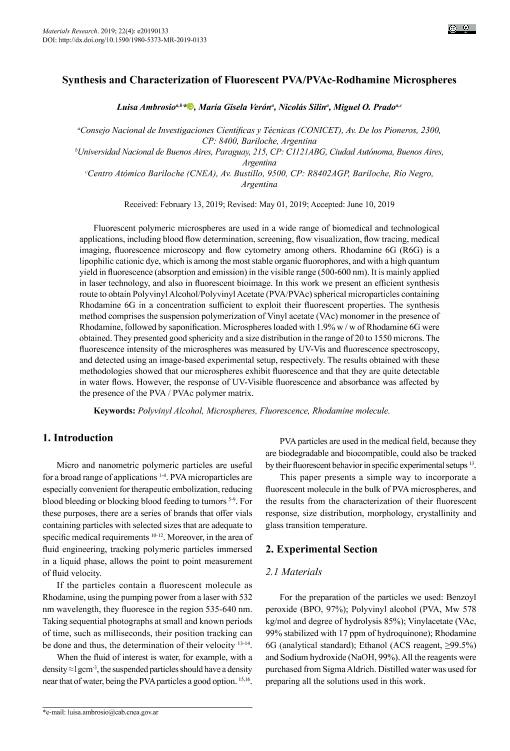Mostrar el registro sencillo del ítem
dc.contributor.author
Ambrosio Tellez, Luisa Fernanda

dc.contributor.author
Verón, María Gisela

dc.contributor.author
Silin, Nicolas

dc.contributor.author
Prado, Miguel Oscar

dc.date.available
2021-01-27T14:29:13Z
dc.date.issued
2019-07
dc.identifier.citation
Ambrosio Tellez, Luisa Fernanda; Verón, María Gisela; Silin, Nicolas; Prado, Miguel Oscar; Synthesis and characterization of fluorescent PVA/pvac-rodhamine microspheres; Universidade Federal de São Carlos; Materials Research; 22; 4; 7-2019; 1-9
dc.identifier.issn
1516-1439
dc.identifier.uri
http://hdl.handle.net/11336/123887
dc.description.abstract
Fluorescent polymeric microspheres are used in a wide range of biomedical and technological applications, including blood flow determination, screening, flow visualization, flow tracing, medical imaging, fluorescence microscopy and flow cytometry among others. Rhodamine 6G (R6G) is a lipophilic cationic dye, which is among the most stable organic fluorophores, and with a high quantum yield in fluorescence (absorption and emission) in the visible range (500-600 nm). It is mainly applied in laser technology, and also in fluorescent bioimage. In this work we present an efficient synthesis route to obtain Polyvinyl Alcohol/Polyvinyl Acetate (PVA/PVAc) spherical microparticles containing Rhodamine 6G in a concentration sufficient to exploit their fluorescent properties. The synthesis method comprises the suspension polymerization of Vinyl acetate (VAc) monomer in the presence of Rhodamine, followed by saponification. Microspheres loaded with 1.9% w / w of Rhodamine 6G were obtained. They presented good sphericity and a size distribution in the range of 20 to 1550 microns. The fluorescence intensity of the microspheres was measured by UV-Vis and fluorescence spectroscopy, and detected using an image-based experimental setup, respectively. The results obtained with these methodologies showed that our microspheres exhibit fluorescence and that they are quite detectable in water flows. However, the response of UV-Visible fluorescence and absorbance was affected by the presence of the PVA / PVAc polymer matrix.
dc.format
application/pdf
dc.language.iso
eng
dc.publisher
Universidade Federal de São Carlos

dc.rights
info:eu-repo/semantics/openAccess
dc.rights.uri
https://creativecommons.org/licenses/by/2.5/ar/
dc.subject
FLUORESCENCE
dc.subject
MICROSPHERES
dc.subject
POLYVINYL ALCOHOL
dc.subject
RHODAMINE MOLECULE
dc.subject.classification
Otras Ingeniería de los Materiales

dc.subject.classification
Ingeniería de los Materiales

dc.subject.classification
INGENIERÍAS Y TECNOLOGÍAS

dc.title
Synthesis and characterization of fluorescent PVA/pvac-rodhamine microspheres
dc.type
info:eu-repo/semantics/article
dc.type
info:ar-repo/semantics/artículo
dc.type
info:eu-repo/semantics/publishedVersion
dc.date.updated
2020-12-16T18:21:03Z
dc.journal.volume
22
dc.journal.number
4
dc.journal.pagination
1-9
dc.journal.pais
Brasil

dc.description.fil
Fil: Ambrosio Tellez, Luisa Fernanda. Universidad de Buenos Aires; Argentina. Consejo Nacional de Investigaciones Científicas y Técnicas. Centro Científico Tecnológico Conicet - Patagonia Norte; Argentina
dc.description.fil
Fil: Verón, María Gisela. Consejo Nacional de Investigaciones Científicas y Técnicas. Centro Científico Tecnológico Conicet - Patagonia Norte; Argentina
dc.description.fil
Fil: Silin, Nicolas. Consejo Nacional de Investigaciones Científicas y Técnicas. Centro Científico Tecnológico Conicet - Patagonia Norte; Argentina
dc.description.fil
Fil: Prado, Miguel Oscar. Comisión Nacional de Energía Atómica. Gerencia del Área de Energía Nuclear. Instituto Balseiro; Argentina. Comisión Nacional de Energía Atómica. Centro Atómico Bariloche; Argentina
dc.journal.title
Materials Research

dc.relation.alternativeid
info:eu-repo/semantics/altIdentifier/url/http://www.scielo.br/scielo.php?script=sci_arttext&pid=S1516-14392019000400225&tlng=en
dc.relation.alternativeid
info:eu-repo/semantics/altIdentifier/doi/http://dx.doi.org/10.1590/1980-5373-mr-2019-0133
Archivos asociados
